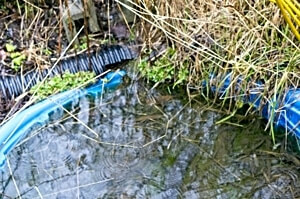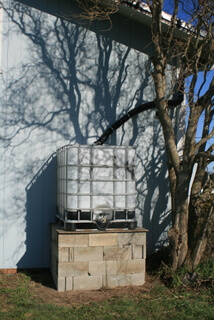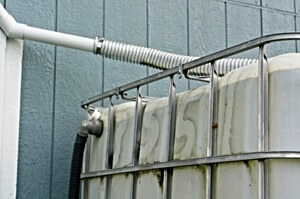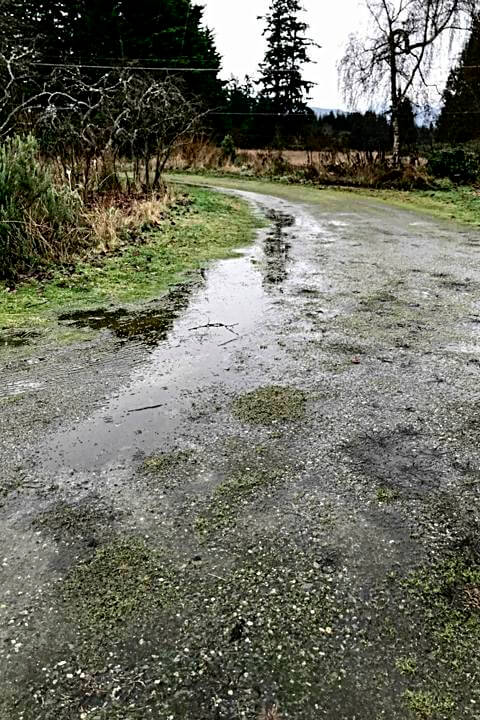
Meteorologists warned us an “atmospheric river” was flowing overhead, and rain it did! I watched it puddle in our driveway, overflow the rain barrels, and turn the entire garden into a sponge. It got me thinking about how I might harvest the rainwater and store this (now plentiful) resource for the dry times ahead.
Of course, this thinking led me down a drainpipe of information on water systems, irrigation methods, water-wise gardening, and much more. Entire books have been written on this stuff. (I highly recommend Brad Lancaster’s comprehensive book, “Rainwater Harvesting for Drylands and Beyond.”) This blogpost is a summary of some of what I learned, an overview of some of the options, and an analysis of what has worked for us (or not) and where we have “room for improvement.”
The Water Cycle – We Thought We Understood It
Now the sun, moving as it does, sets up processes of change and becoming and decay, and by its agency the finest and sweetest water is every day carried up and is dissolved into vapour and rises to the upper region, where it is condensed again by the cold and so returns to the earth.
~Aristotle, Meteorologica
It’s a transient resource, this rain, circling round and round, condensing, raining, infiltrating, evaporating, transpiring, and upcycling, sometimes freezing, sometimes thawing, flowing, seeping, or standing still – vital to all of life, termed by some “the blood of the earth,” revered in some cultures, underappreciated and carelessly contaminated in others…but lest I digress down a philosophical river…
The thing is – it’s not just one big water cycle – it’s also a whole bunch of smaller water cycles all happening at once, affecting regional water patterns all over the world – from rainforest to parched desert and everything in between.
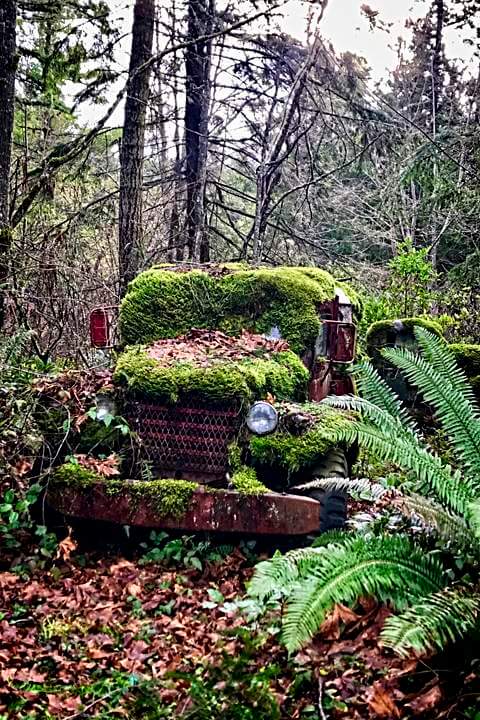
All we want to do here is just interrupt this motion for a moment and temporarily divert it for our own selfish uses, right? In which case, by interjecting ourselves, we, too, become a part of that circle – which we must do every single day to survive – and if not, then we decay and become a part of a different cycle. And there I go again down another philosophical river….
The reality is, though, what we do now can have a huge influence on how much we have later – and since water is essential to our very existence, and water is intricately connected with weather patterns, our food, and the food web upon which the ecology of the planet is based – it is good to review how the hydrological cycle works and think about what we can do to conserve as much as we can and keep the cycle in balance. Studies show that our supply of freshwater is diminishing. (Macklin 2015; Richey et al., 2015).
The Main Idea
However, without going off the deep end, let’s get back to our main objective. It’s the rainy season. We want to capture the rain while it is plentiful and then use various techniques to store it, slow it down, and direct it where we want it to go. Methods might include the use of barrels, rain gardens, ponds, and swales — and we might also consider how plants and soil play a role in the efficiency of these systems. What often works best is not any one thing but a multi-pronged approach using a variety of methods depending on the situation (of course).

Understanding the Landscape
First, though, we need to understand rainfall patterns, topography, our soils, and other factors to better determine what might work best on our particular homescape. We need to ask practical questions:
- How much rain are we talking about?
- Where are the concentrated sources – e.g., creeks, downspouts, runoff?
- Where and in what directions are the slopes to the land; where are the high and low areas?
- Are there patterns to where the water drains? Does it pool up anywhere?
- Where is water wasted? Where can it be captured or re-used?
Our General Climate Conditions
Barbolian Fields, located in NW Washington State, is classified as “semi-desert” in Zone 8b. We average only 13-16” of rain per year, most of which falls between October and March. This so-called “Mediterranean” climate is typified by wet winters and very dry, relatively cool summers. We also get a lot of wind, which has a habit of whisking away any drizzle or morning dew that might try to accumulate. Needless to say, we have to make the most of every drop we get.
Our local weather is influenced a lot by the Pacific Ocean and the Olympic Mountains. The clouds come in off the ocean, bump into the mountains, and dump whatever they are carrying. Other clouds might wrap around and reconnect in what they call the “convergence zone” on the other side. People in that area get the double whammy. Sequim, the “blue hole,” frequently gets missed.
For comparison, Forks, WA, located just 1.5 hours away, gets about 10 feet of rain every year! Seattle gets around 38”. Sequim is closer, precipitation-wise, to Salt Lake City and San Diego, which both average close to 16”.
How to Calculate Gallons of Rainwater from the Roof
So – how much water can you harvest from off a roof? Simply calculate the square footage (And don’t make the silly mistake I once did of calculating the square footage of the slope. Just because a slope has more square footage doesn’t mean any more water will be falling from the sky on that space! Keep it simple. Square footage of the building footprint, including the roof eves = length x width.)
Formula 1: Gallons of water = inches of rain x square footage x 0.623 (i.e., 1” falling on 1 square foot yields roughly 0.623 gallons).
Formula 2: Gallons of water = feet of rain (or inches/12) x square footage x 7.48 (This formula converts measurements of water to cubic feet.) (i.e., 1/12 = 0.083. So, 0.083 x 7.48 = 0.623. Meaning, 0.083 feet of rain on 1 square foot yields 0.623 gallons)
Both formulas come out very close. Of course, the total is assuming 100% efficiency, which doesn’t happen. You could multiply your result by 80% or 90%, for example, to get a more realistic estimate.
What did we get so far in this “water year” (October 1, 2020 to January 31, 2021)?
Accumulative Rainfall for Station WA-CM-29, as recorded from our backyard into the CoCoRaHS system (Community Collaborative Rain, Hail, and Snow network):
- October: 1.41”
- November: 3.38”
- December: 3.53” (included 1.5” snow, melted for water content measure)
- January: 2.48”
Total: 10.80” so far in this water year, which means we’ve received roughly 2/3 of our yearly allotment in just 4 months.
How Much Water Are We Talking About?
After just 1” of rain…
- House footprint = 1063 sq ft x 0.623 = 662.24 gallons
- Barn footprint = 2754 sq ft x 0.623 = 1,715.74 gallons!
- Greenhouse = 224 sq ft x 0.623 = 139.55 gallons/inch of rain!
Formula 2 (for comparison):
- 1063 x .0833 x 7.48 = 662.60 gal
- 2754 x .0833 x 7.48 = 1716.66
- 224 x .0833 x 7.48 = 139.626
Based on these formulas, Barbolian Fields could possibly collect 2,517.54 GALLONS of water with just one measly inch of rain!!! We have already had over 11” in this water year (including the half inch we received the past couple of days), so that is nearly 27,693 gallons since October. Just off the roofs. Wow.
Suddenly our 55-gallon barrels and the two “super-size” 275-gallon catchment tanks seem ludicrously inadequate. It also explains why the corkscrew willow planted at one corner of the barn is almost overtaking the entire area.
Get this: One inch of rain falling on one acre of land amounts to 27,137.88 gallons (give or take a few gallons, depending on the formula: 43,560 sq ft x 0.623) It’s hard to imagine, but I kid you not. And by most standards, that is not a lot.
A Word About Stormwater Management
Stormwater management is a big topic that can include anything and everything coming down the pipe: runoff from roofs, yards, hillsides, streets, parking lots… All this water can pick up all kinds of particulates, motor oil, pet and other animal wastes, and who knows what as it flows downhill to wherever it is going. This “non-point source pollution” can be hard to track down; the slurry soaks into our water table, runs down into streams, and finds its way into other waterways. Even if your particular homesite is not greatly affected by this pollution, it is good to be aware of how easily we can all contribute to the problem.
Municipalities invest a lot of money in stormwater management systems. Obviously, I am not going to build a large retention facility or a series of underground vaults and filtration systems. I wondered, though, could some of these concepts be scaled down to backyard size and what could we do to mimic what nature does on its own?
Containers: Rain Barrels, Tanks, Cisterns, and the Like
Rain Barrels
When we think of capturing rainwater, a simple 55-gallon barrel under a downspout is often the first thing that comes to mind. Easy. However, I’ve realized two things: 1) they fill up very quickly (our calculations of how many gallons can be collected with an inch of rain make it quite obvious), and 2) there’s too much water when you don’t need it and never enough when you do.

Still – they can come in handy. Our greenhouse rain barrel provides water all winter and into spring for inside the greenhouse. However, our system definitely needs improvement. We are not adequately diverting the overflow, which is an important resource that shouldn’t be wasted. As noted above, 1” of rain, which doesn’t happen often, but can add up over time, will dump nearly 120 gallons of water down a 60-degree slope into my little 55-gallon barrel. And if that barrel already has some water in it, that means even more is just overflowing into the little garden around it. I’m not even capturing the additional 20 gallons that drains off the back side and waters a bunch of invasive blackberries. Ugh. They are taking over.
I built a little garden around the rain barrel in which I planted water-loving gypsywort, an interesting wetland plant that has both medicinal and dye properties, and some chufa, which got lost in all the tangles. They appreciate water but don’t like to be drowning! I could extend the bed to include watercress, marshmallows, and other sun and water loving plants – or possibly divert some of the runoff to other nearby beds.
As an aside, some mullein somehow landed in this little garden spot this last year, so I let it grow. I usually think of it as a dryland plant in Eastern Washington, so when it shows up in our back acre, I consider it a gift. Well, it was the tallest, largest mullein I’ve ever seen in my life, and it offered me an abundance of leaves and flowers. Perhaps it is a plant that loves water but also grows just fine when it is hot and dry.
As for the 20 gallons that run off the back, I have been thinking of setting up a little bathtub pond, maybe put some goldfish in it, and grow a few plants on top – a mini-aquaponics system without too much effort. Used bathtubs at our local second hand are cheap and always available. I am currently using one to house my red wigglers. The tubs don’t have to look tacky if you put plants around them. Not a problem for me. Another idea would be to build a trough in which to soak my willow rods, something I’ve been meaning to do ever since the County piped our open irrigation ditch.
The Barn Tanks
In 2013, we installed two 275-gallon tanks on each side of the barn. They look like big plastic cubes in a metal cage.
The overflow from each tank is routed to two different “pond” areas: one to a simple kiddie pool sunk in the ground in the willows and the second to a small dug-out pond on the other side of the barn. The overflow from each of these is routed to the surrounding areas where we’ve planted water-loving plants: more willows, Joe Pye weed, rhubarb, black cohosh, and udo on the first, and around the second, a (now) huge bay shrub (Laurus nobilis), an American highbush cranberry, a medlar tree, some bamboo, aronia berries, angelica, and some assorted herbs.
It’s important to note that all these plants are able to tap into that moist soil, even though they are not right next to the ponds.
Both ponds need to be cleaned out at this time of year, which is like harvesting another resource: leaves and debris that have broken down and will make nutrient-rich mulch for nearby plants. Our reward: Frogs serenade us in the spring. 🙂

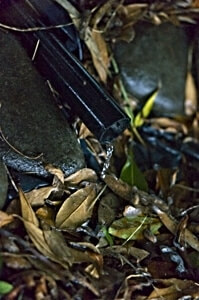
You know, I thought the tanks were huge when we first put them in, but calculations show a mere 1” of rain on that barn can produce over 1700 gallons of water! It is good we set up the overflow routes right at the get-go. We wouldn’t want all that water right next to the foundation.
Two considerations on the installation: weight and elevation. One gallon of water weighs 8.33 pounds; so, 275 gallons will weigh approximately 2,290 pounds! We placed each tank on a 3-foot foundation of pumice blocks. The gravity flow is extremely slow. That’s ok. We’re in no hurry. One side connects to a drip irrigation system routed through a nearby garden. We can also open a faucet to fill a bucket.
The fact remains, though, that we’d have to have a lot more rain barrels and tanks lined up to catch potentially 38,000 gallons of rain over the year. Even if we had the space, the barrels and tanks can be expensive and are not always easy to find second hand. Our local health food store was a good source; they get shipments of honey and oil in them.
What About Cisterns?
Next, I checked into cisterns. I like the idea of cisterns and did not realize how many old homes across the U.S. have old cistern systems. I always thought of them as big bulky ugly things – but that is not necessarily the case. They can be incorporated into the landscape and serve multi-purposes – such as support pillars, fences, or privacy screens. They come in tall narrow sizes as well as round. I think they will become better appreciated as we move into drier times. It would be nice to be able to include a cistern system in a new construction plan; however, our house was built in 1904. We don’t have a lot of room. I just don’t know where I would put one at this point. Plus, the expense of the tank, the installation, a pump system, retrofitting our plumbing, etc., is just a bit beyond us right now.
I often wonder about the stories this old house could tell. At some point, someone had put a large open barrel in the ground beneath the front deck to catch some of the greywater. I am not sure it really went anywhere after that. It was rusty, had dead rodents in it, and smelled. Not a safe situation. We removed it. The kind of cisterns I’m talking about, though, are for collecting clean rainwater, not distributing greywater – which is a whole other topic.
Final answer: As much as I like cisterns, we don’t have the room in our little backyard setup.
Conclusions
These are some ideas I had about using containers to capture rainwater. In our situation, we have found they are handy but can only do so much. I have often read, though, that the best place to store water is in the soil. So that is what I looked at next, and in the spirit of keeping this readable, I will put that in a separate blog post. I would be interested in finding out from my readers what kind of catchment containers you use and what has worked best for you. Thanks for reading and sharing your thoughts.
References and Resources
Bellingen Permaculture. “22 Water Conservation Techniques.”
City of Bellingham, Washington 2020 Stormwater Management Program. (Scroll past the table to get to the heart of what they did.)
Flores, Heather J. 2006. Food Not Lawns: Chapter on The Ecological Home Water Cycle. (Sign up to read her entire book for free! She also offers an entire 52-week permaculture course for free.)
Gamble, Morag. Masterclass #12: Design for water Resilience in Your Garden. YouTube Video.
Hemenway, Toby. 2009. Gaia’s Garden – A Guide to Home-Scale Permaculture, 2nd Edition. Chelsea Green Publishing. (This book was my introduction to Permaculture. I still love it.)
Krav?ík, M., J. Pokorný, J. Kohutiar, M. Ková?, E. Tóth. 2007. Water for the Recovery of the Climate – A New Water Paradigm. This publication originated through partner cooperation between the People and Water NGO, the Association of Towns and Municipalities of Slovakia, the community help society ENKI and the Foundation for the Support of Civic Activities. (An in-depth study that will increase your understanding of the water cycle, its connection to climate, and how human activities affect its equilibrium.)
Lancaster, B, 2010. Rainwater Harvesting for Drylands and Beyond: Guiding Principles to Welcome Rain into Your Life and Landscape. Volume 2. Rainsource Press: Tucson, USA (distributed by Chelsea Green: New York, USA).
Macklin, Malorie. 2015. The World Is Running Out of Fresh Water. Here’s What You Can Do to Make a Difference. One Green Planet.
Mollison, Bill. 1988. Permaculture: A Designer’s Manual. Tagari Publications. (If you’ve always wanted the foundation book on permaculture, it is currently available through Amazon for $345 [yikes!] – but Tagari Publications out of Australia now has a U.S. outlet, where you can buy it for $114.95. Sales are restricted to one per person. I am not an affiliate, but I do have the book and read the entire 568 pages.)
Philadelphia Stormwater Manual. (They deal with a lot of water.)
Richey, A. S., B. F. Thomas, M.-H. Lo, J. T. Reager, J. S. Famiglietti, K. Voss, S. Swenson, and M. Rodell (2015), Quantifying renewable groundwater stress with GRACE, Water Resour. Res., 51, 5217–5238, doi:10.1002/ 2015WR017349. (A NASA-funded study for those who like the science.)
Schwartz, Judith D. Water in Plain Sight. Chelsea Green Publishing. (I admit, I have not yet read this book; it is on my wish list. The reviewers write “Long taken for granted, water availability has become dependent on economics, politics, and people’s food and lifestyle choices…. Water does not perish, nor does it require millions of years to form as do fossil fuels. However water is always on the move and we must learn to work with its natural movement.”)
Stormwater Partners of SW Washington and the City of Olympia. “Managing Stormwater – An introduction to maintaining stormwater facilities for private property owners and HOAs.” Published with grant funding from the Washington State Department of Ecology. (This is close to home for me.)
You Might Also Like These Posts from Barbolian Fields
- Climate: Temperatures, Precipitation, Wind
- Rainwater Collection System
- Water Year 2019 Synopsis: Weathering the Weather
